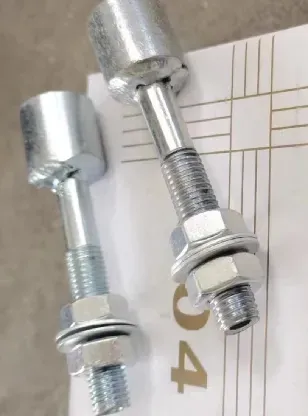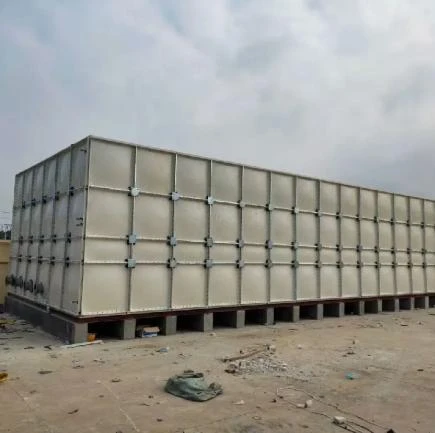loading...
- No. 9, Xingyuan South Street, Dongwaihuan Road, Zaoqiang County, Hengshui, Hebei, China
- admin@zjcomposites.com
- +86 15097380338
- Welcome to visit our website!
High-Performance FRP Tank and Vessel Solutions Durable, Efficient, Versatile
- Introduction to frp tank and vessel
: Industry Context and Material Overview - Key Data Insights and Mechanical Advantages of FRP Solutions
- Comparative Review: FRP vs Reinforced Concrete with FRP Bars
- Prominent Manufacturers and Supplier Differentiators: Table Analysis
- Custom Engineering and Design Considerations for Varied Applications
- Industry Case Studies: Whole House Water Filter and Softener Implementation
- Conclusion: The Strategic Edge of frp tank and vessel Technology

(frp tank and vessel)
Introduction to frp tank and vessel: Industry Context and Material Overview
Within a demanding world of storage and fluid process containment, frp tank and vessel solutions have emerged as vital assets for industries spanning water treatment, chemical processing, food, and agriculture. Fiberglass reinforced plastic (FRP) composites unite lightweight construction with superior chemical resistance, outpacing traditional metals and concrete. This segment examines the evolution and composition of FRP tanks, spotlighting their multilayered fabrication—especially the resin-rich corrosion barrier, structural laminate, and durable outer coating.
As regulatory standards for containment integrity rise globally, nonmetallic solutions such as FRP outperform for environments where durability and corrosion resistance are critical. Statistical data reveals that the global FRP tank market reached approximately $2.1 billion in 2023 and is projected to grow at a CAGR of 4.8% through 2030. This surge links directly to stringent chemistry handling requirements, increasing demand for advanced water filtration solutions, and rapid urbanization.
Key Data Insights and Mechanical Advantages of FRP Solutions
The appeal of FRP tanks and vessels lies fundamentally in their superiority in material properties. Unlike steel, FRP does not succumb to rust, and unlike unreinforced plastics, it withstands significant pressure and impact loads. FRP composites demonstrate a strength-to-weight ratio up to 5–7 times greater than traditional metals and roughly 3 times that of standard Grade 60 reinforced concrete with steel rebars.
In terms of mechanical data, FRP materials typically offer tensile strengths between 50,000–120,000 psi, modulus of elasticity in the range of 2.5–4.2 million psi, and flexural strengths exceeding most alternative polymer solutions. Their performance is further enhanced by their low thermal conductivity (0.15–0.3 W/m.K), making FRP ideal for applications demanding thermal insulation.
The application of FRP bars within reinforced concrete structures enables enhanced crack control and corrosion immunity in aggressive environments. Moreover, life cycle assessments display that maintenance costs for FRP vessels are up to 65% lower than for similarly sized metallic tanks over a 25-year period. These data-driven insights vividly outline the mechanical edge of FRP in critical infrastructure.
Comparative Review: FRP vs Reinforced Concrete with FRP Bars
When considering reinforced concrete with frp bars mechanics and design, the comparison to monolithic FRP tank and vessel configurations becomes especially relevant in large-scale civil and industrial projects. Both systems leverage the noncorrosive advantages of polymer reinforcement, but their performance profiles, maintenance demands, and costs diverge.
| Feature | FRP Tank and Vessel | Reinforced Concrete with FRP Bars |
|---|---|---|
| Corrosion Resistance | Excellent (Chemical/Biological) | Very Good (Limited to bar exposure) |
| Structural Weight | Low (Lightweight, 25% of steel) | High (Concrete density: 2400 kg/m³) |
| Installation Time | Quick (Prefabricated) | Longer (Onsite casting, curing) |
| Maintenance Frequency | Minimal (Occasional checks) | Periodic (Potential cracking) |
| Lifecycle Cost (25 yrs) | Low ($, minimal repair) | Medium ($$, patch/rehab) |
| Customizability | High (Shapes, fittings, scale) | Medium (Formwork limits) |
| Thermal Insulation | Superior (Low conductivity) | Poor (Conductive) |
| Seismic Performance | Flexible, high energy absorption | Brittle, may require dampers |
While reinforced concrete with FRP bars offers significant durability for embedded structures, FRP tanks and vessels dominate in ease of installation, modularity, and long-term reliability—especially vital for applications like chemical handling and advanced water filtration systems.
Prominent Manufacturers and Supplier Differentiators: Table Analysis
The global market for FRP tanks and vessels is defined by several leading players, each providing unique value in fabrication technology, certifications, customization, and after-sales service. Discerning buyers should compare vendor capabilities not just by product range but also by technical support, warranty provisions, and track record in challenging environments.
| Manufacturer | Design Compliance | Customization Level | Warranty/Support | Certifications | Notable Projects |
|---|---|---|---|---|---|
| Enduro Composites | ASME RTP-1, ASTM D3299 | High (Diameter up to 12m) | 10yrs / 24-7 Support | ISO 9001, NSF/ANSI 61 | Municipal Water Plants |
| Fiber-Tech Industries | ASME, API 650 | Medium | 5yrs / Standard | UL, AWWA D120 | Food & Beverage, Firewater |
| Belco Manufacturing | ASME RTP-1 | Very High (Integration-ready) | 10yrs / 48hr Site Response | FM, ISO 9001 | Chemical Treatment Plants |
| Plas-Tanks Industries | ASME RTP-1, API 12P | High (Accessories / Fittings) | 10yrs / Extended | NSF/ANSI 61 | Water Filtration Skids |
The table highlights that warranty, technical response, and standards compliance differ significantly. For critical systems such as whole house water filter and softener tanks, opting for manufacturers with robust certifications and documented performance is crucial.
Custom Engineering and Design Considerations for Varied Applications
Engineering the optimal FRP tank or vessel encompasses more than selecting capacities; it demands assessment of factors such as process chemistry, pressure/temperature profiles, regulatory codes, and site constraints. Customization stretches from various resin systems (vinyl ester, polyester, epoxy) to double-wall containment, integral mixers, insulation, and nozzle configurations.
For water filtration and softening plants, critical aspects include NSF/ANSI 61 certification for potable water, internal surface smoothness to limit biofilm, and compatibility with granular media. In aggressive industrial settings, specifying UV inhibitors, fire-retardant resins, and supports for seismic/vibration loads may be vital. Some high-capacity FRP vessels are designed to withstand full vacuum (–1 barg) and internal pressures up to 10 barg, with accessories like integrated manways for easy maintenance.
The following checklist outlines the design steps commonly employed in a custom FRP tank solution:
- Material compatibility analysis and chemical exposure evaluation
- Dimensional sizing and layout definition, including access needs
- Mechanical reinforcement and support detailing for both static and dynamic loads
- Finite element modeling of stress distribution (especially for >100m³ models)
- Quality assurance (hydrotest, non-destructive ultrasonic testing, documentation traceability)
Industry Case Studies: Whole House Water Filter and Softener Implementation
As demand grows for sustainable water solutions, the deployment of whole house water filter and softener systems utilizing FRP tanks has accelerated, particularly in settings such as apartment complexes, hospitals, and large residential estates. One 2023 project in Houston, Texas, featured 180 dual-chamber FRP vessels installed for an integrated municipal filter/softener retrofit, servicing over 2,200 households. System downtime was reduced by 68% compared to the previous concrete tank installation.
In another scenario, a food processing facility in the Midwest replaced six aging metallic tanks with custom-filament wound FRP alternatives for both potable and process water. The outcome: water ingress incidents were eliminated; annual savings on chemical cleaning alone approached $45,000, and water hardening was cut from 200 ppm to below 40 ppm due to enhanced softening uniformity. These improvements directly connect to the smooth interior finish and inert behavior of FRP, reducing scale buildup and maintenance cycles.
Such case studies illustrate not only the functional benefits of FRP vessels for whole house applications but also their positive environmental impact. Recyclable resins and lower energy input during manufacturing align with corporate sustainability goals, a deciding factor for municipalities and industrial asset managers alike.
Conclusion: The Strategic Edge of frp tank and vessel Technology
When assessing the adoption of frp tank and vessel systems, it becomes clear they offer strategic advantages over legacy materials in both technical and economic terms. Quantifiable data, as outlined above, demonstrates their viability for everything from whole house water filter and softener installations to advanced chemical containment.
Forward-thinking infrastructure and facility operators increasingly favor FRP not only for its unparalleled corrosion resistance and customization breadth but also due to lifecycle savings and regulatory compliance. As investment continues to shift toward sustainable, high-performance infrastructure, the role of FRP tank and vessel technology will only deepen, ensuring resilient and efficient operational outcomes for decades ahead.

(frp tank and vessel)
FAQS on frp tank and vessel
Q: What are the primary benefits of using an FRP tank and vessel in water treatment systems?
A: FRP tanks and vessels offer excellent corrosion resistance, lightweight structure, and long service life compared to traditional materials. They are ideal for storing chemicals and water in harsh environments. Their durability makes them cost-effective over time.Q: How does reinforced concrete with FRP bars improve mechanics and design?
A: Reinforced concrete with FRP bars combines the strength of concrete with the non-corrosive nature of FRP reinforcements. This increases the structural lifespan and reduces maintenance needs. It's especially advantageous in marine or chemically aggressive environments.Q: Can an FRP tank and vessel be used alongside a whole house water filter and softener?
A: Yes, FRP tanks and vessels are commonly used as housings or storage containers in whole house water filtration and softening systems. They safely handle various water chemistries. Their inert nature ensures water quality is maintained.Q: What maintenance is required for FRP tank and vessel solutions?
A: FRP tanks and vessels require minimal maintenance, mainly routine inspections for physical damage and periodic cleaning. Their corrosion resistance means less frequent repairs compared to metal alternatives. Always follow manufacturer guidelines for optimal longevity.Q: Why choose reinforced concrete with FRP bars over traditional steel reinforcement?
A: FRP bars do not rust or corrode, providing superior long-term durability in reinforced concrete structures. This reduces potential structural failures and enhances safety. They're a smart choice for cost efficiency in corrosive environments.-
GRP Structures: The Future of Lightweight, High-Performance EngineeringNewsJun.20,2025
-
FRP Water Tank: High-Performance Storage for Corrosive and Clean Water SystemsNewsJun.20,2025
-
FRP Square Tube: The New Industry Standard for Chemical and Structural ApplicationsNewsJun.20,2025
-
FRP Pultruded Profiles: The Ultimate Choice for Lightweight Structural StrengthNewsJun.20,2025
-
FRP Handrails: The Safer, Smarter, and Stronger Choice for Modern InfrastructureNewsJun.20,2025
-
FRP Grating: The Smart Solution for Durable, Lightweight Industrial FlooringNewsJun.20,2025
-
Why Choose a Galvanized Water Tank for Your Storage NeedsNewsMay.21,2025
